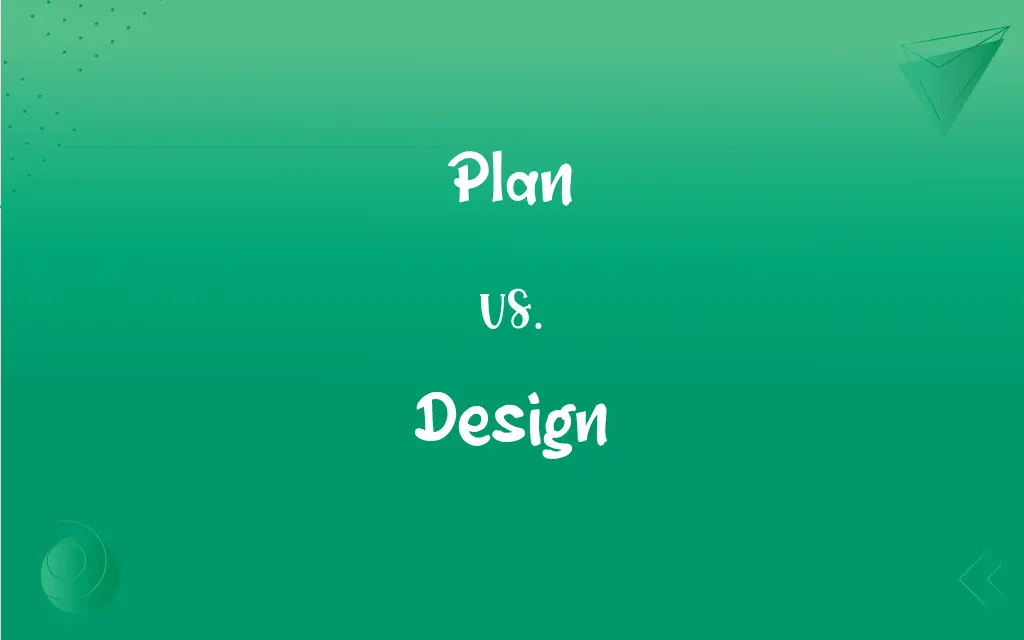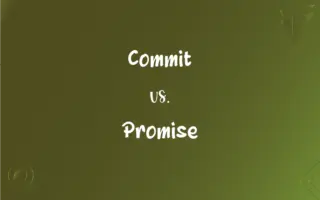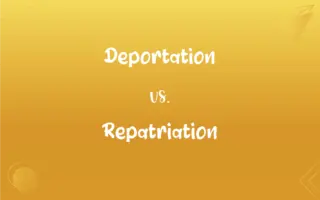Plan vs. Design: What's the Difference?
Edited by Aimie Carlson || By Harlon Moss || Updated on November 10, 2023
"Plan" refers to a detailed proposal or scheme for achieving an objective, while "design" involves creating and arranging elements in a project for aesthetic and functional purposes.

Key Differences
"Plan" and "design" are both integral in the development of projects but serve different roles. A plan outlines the steps and strategies for achieving an objective, emphasizing organization and direction. Design, in contrast, focuses on the aesthetic and functional aspects of a project, detailing how it will look and work.
A plan is more about the 'what' and 'when' of a project, detailing objectives, timelines, and resources. It acts as a roadmap for achieving goals. Design, however, is more about the 'how' and 'why,' focusing on the artistic and technical specifications of a project, ensuring it is both appealing and functional.
In planning, the emphasis is on feasibility, efficiency, and effectiveness, aiming for a structured approach to reaching a goal. Designing, on the other hand, requires creativity and innovation, focusing on the user experience, visual appeal, and practicality of the end product.
Plans are often used in a variety of fields, from business strategies to personal goals, where a clear structure and sequence of actions are necessary. Design is more specific to fields like architecture, product development, and graphic arts, where aesthetic and usability are key considerations.
While planning involves setting goals, identifying tasks, and allocating resources, designing involves choosing colors, materials, layout, and functionality. Both are essential for successful project completion, but they address different aspects of the process.
ADVERTISEMENT
Comparison Chart
Focus
Strategy and logistics
Aesthetics and functionality
Role
Outlines steps and objectives
Details visual and practical aspects
Key Elements
Goals, timelines, resources
Color, layout, user experience
Field of Application
Business, personal goals
Architecture, product development
End Objective
Achieving specific goals
Creating an appealing, functional product
ADVERTISEMENT
Plan and Design Definitions
Plan
Pre-arranged steps towards a goal.
She made a plan= for her career advancement.
Design
Developing the look and function of something.
She admired the design of the new smartphone.
Plan
An ordered set of actions for a purpose.
The event's plan= covered every hour of the day.
Design
Detailing functional aspects of a product.
The engineer focused on the design of the machine's components.
Plan
A detailed proposal for achieving something.
Their plan= included a timeline for the project's completion.
Design
The aesthetic aspect of something.
The design of the poster captivated everyone's attention.
Plan
A systematic approach for an objective.
The team's plan= focused on efficient resource allocation.
Design
Tailoring products for user needs and comfort.
The website's design was user-friendly and intuitive.
Plan
A structure for setting and achieving objectives.
His financial plan= outlined his savings and investments.
Design
Combining aesthetics with functionality.
The interior design perfectly balanced beauty and utility.
Plan
An orderly or step-by-step conception or proposal for accomplishing an objective
A plan for improving math instruction.
Design
To conceive or fashion in the mind; invent
Design a good excuse for not attending the conference.
Plan
A proposed or intended course of action
Had no plans for the evening.
Design
To formulate a plan for; devise
Designed a marketing strategy for the new product.
FAQs
Can a plan= exist without a design?
Yes, a plan= can outline objectives without detailing the design aspects.
Is a plan= always documented?
Generally, yes. Documenting a plan= helps in clarity and communication.
Can a design change during the planning phase?
Yes, design elements can be modified during planning as objectives and constraints become clearer.
Does a plan= have to be rigid?
No, plans can be flexible and adapt to changing circumstances.
Are all designs artistic?
Not necessarily. Some designs are more technical and functional than artistic.
Is design always related to physical products?
No, design can also apply to digital products and services.
Are plan= and design interdependent?
Often, but not always. Some projects require detailed planning and design, while others may need only one of the two.
Does design focus more on aesthetics or functionality?
Design often balances both aesthetics and functionality, though the focus can vary based on the project.
Can anyone create a plan=?
Yes, planning is a skill that can be developed and utilized by anyone.
Is user experience always a part of design?
In many modern designs, especially in digital products, user experience is a key consideration.
Can design be purely functional without aesthetic considerations?
Yes, especially in industrial or engineering contexts.
Do plans= change more frequently than designs?
Plans can be more dynamic and subject to change based on circumstances.
Can a plan= be successful without a good design?
It depends on the nature of the project, but generally, both good planning and design contribute to success.
How detailed should a plan= be?
The level of detail in a plan= varies based on the complexity and requirements of the project.
Is designing a creative process?
Yes, design typically involves creativity and innovation.
Are digital tools necessary for making a plan=?
Digital tools can be helpful but are not always necessary.
Is design important in service industries?
Yes, service design is crucial for user experience and efficiency.
How does technology impact design?
Technology expands design possibilities and can enhance both aesthetics and functionality.
Does environmental impact play a role in design?
Yes, especially in sustainable and eco-friendly designs.
Can a plan= cover multiple projects?
Yes, a plan= can be broad, covering multiple related projects.
About Author
Written by
Harlon MossHarlon is a seasoned quality moderator and accomplished content writer for Difference Wiki. An alumnus of the prestigious University of California, he earned his degree in Computer Science. Leveraging his academic background, Harlon brings a meticulous and informed perspective to his work, ensuring content accuracy and excellence.
Edited by
Aimie CarlsonAimie Carlson, holding a master's degree in English literature, is a fervent English language enthusiast. She lends her writing talents to Difference Wiki, a prominent website that specializes in comparisons, offering readers insightful analyses that both captivate and inform.































































